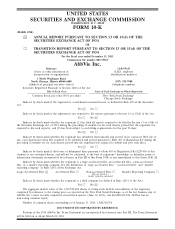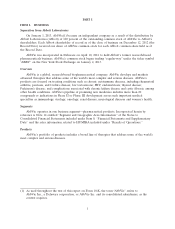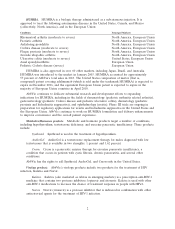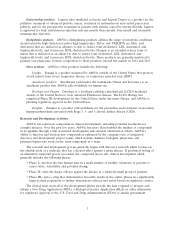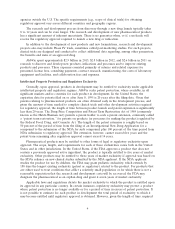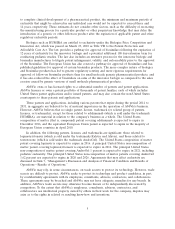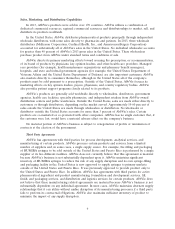AbbVie 2013 Annual Report Download - page 14
Download and view the complete annual report
Please find page 14 of the 2013 AbbVie annual report below. You can navigate through the pages in the report by either clicking on the pages listed below, or by using the keyword search tool below to find specific information within the annual report.reimbursement, sampling, distribution, quality control, post-marketing surveillance, record keeping,
storage, and disposal practices. AbbVie’s operations are also affected by trade regulations in many
countries that limit the import of raw materials and finished products and by laws and regulations that
seek to prevent corruption and bribery in the marketplace (including the United States Foreign Corrupt
Practices Act and the United Kingdom Bribery Act, which provide guidance on corporate interactions
with government officials) and require safeguards for the protection of personal data. In addition,
AbbVie is subject to laws and regulations pertaining to health care fraud and abuse, including state and
federal anti-kickback and false claims laws in the United States. Prescription drug manufacturers such
as AbbVie are also subject to taxes, as well as application, product, user, establishment, and other fees.
Compliance with these laws and regulations is costly and materially affects AbbVie’s business.
Among other effects, health care regulations substantially increase the time, difficulty, and costs
incurred in obtaining and maintaining approval to market newly developed and existing products.
AbbVie expects compliance with these regulations to continue to require significant technical expertise
and capital investment to ensure compliance. Failure to comply can delay the release of a new product
or result in regulatory and enforcement actions, the seizure or recall of a product, the suspension or
revocation of the authority necessary for a product’s production and sale, and other civil or criminal
sanctions, including fines and penalties.
In addition to regulatory initiatives, AbbVie’s business can be affected by ongoing studies of the
utilization, safety, efficacy, and outcomes of health care products and their components that are
regularly conducted by industry participants, government agencies, and others. These studies can call
into question the utilization, safety, and efficacy of previously marketed products. In some cases, these
studies have resulted, and may in the future result, in the discontinuance of, or limitations on,
marketing of such products domestically or worldwide, and may give rise to claims for damages from
persons who believe they have been injured as a result of their use.
Access to human health care products continues to be a subject of investigation and action by
governmental agencies, legislative bodies, and private organizations in the United States and other
countries. A major focus is cost containment. Efforts to reduce health care costs are also being made in
the private sector, notably by health care payors and providers, which have instituted various cost
reduction and containment measures. AbbVie expects insurers and providers to continue attempts to
reduce the cost of health care products. Outside the United States, many countries control the price of
health care products directly or indirectly, through reimbursement, payment, pricing, coverage
limitations, or compulsory licensing. Budgetary pressures in the United States and in other countries
may also heighten the scope and severity of pricing pressures on AbbVie’s products for the foreseeable
future.
United States. Specifically, U.S. federal laws require pharmaceuticals manufacturers to pay certain
statutorily-prescribed rebates to state Medicaid programs on prescription drugs reimbursed under state
Medicaid plans, and the efforts by states to seek additional rebates affect AbbVie’s business. Similarly,
the Veterans Health Care Act of 1992, as a prerequisite to participation in Medicaid and other federal
health care programs, requires that manufacturers extend additional discounts on pharmaceutical
products to various federal agencies, including the United States Department of Veterans Affairs,
Department of Defense, and Public Health Service entities and institutions. In addition, recent
legislative changes would require similarly discounted prices to be offered to TRICARE program
beneficiaries. The Veterans Health Care Act of 1992 also established the 340B drug discount program,
which requires pharmaceuticals manufacturers to provide products at reduced prices to various
designated health care entities and facilities.
In the United States, most states also have generic substitution legislation requiring or permitting a
dispensing pharmacist to substitute a different manufacturer’s generic version of a pharmaceutical
product for the one prescribed. In addition, the federal government follows a diagnosis-related group
10


